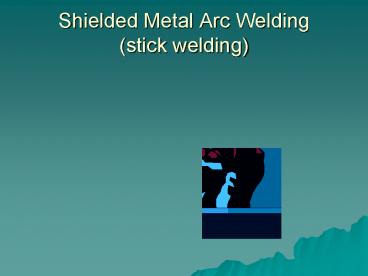Shielded Metal Arc Welding (stick welding) - PowerPoint PPT Presentation
1 / 26
Title:
Shielded Metal Arc Welding (stick welding)
Description:
Shielded Metal Arc Welding (stick welding) Uses Farms Service Stations Large Construction Sites Pipelines (Most used type of Welding!!!!) SMAW Safety Cover all skin ... – PowerPoint PPT presentation
Number of Views:864
Avg rating:3.0/5.0
Title: Shielded Metal Arc Welding (stick welding)
1
Shielded Metal Arc Welding(stick welding)
2
Uses
- Farms
- Service Stations
- Large Construction Sites
- Pipelines
- (Most used type of Welding!!!!)
3
SMAW Safety
- Cover all skin to prevent Radiation burns
- Cover hair to prevent sparks setting hair on fire
- Wear ear plugs to protect from noise and burning
ear drums with sparks - Use a 14 shade welding helmet to protect eyes
- Wear safety glasses at all times
- Make sure pants pockets are empty
4
Duty Cycle
- Length of time a welder can be used continually
at its rated output in any 10 minute period - Thunderbolt AC/DC machines are 20 duty cycle
- At 150 amps DC welder can be used for 2 minutes
in a 10 minute period. - At 100 amps DC can be used about 5 minutes in a
10 minute period.
5
Electrodes
- SMAW uses a consumable electrode that contains a
flux coating - The flux produces a protective gas around the
weld - CO (Carbon Monoxide)
- H2 (Hydrogen)
- Removes impurities from the molten metal
- Forms slag to protect weld as it cools
6
Electrode Care
- Electrodes must be kept dry
- Dampness will introduce hydrogen into the weld
causing cracking or brittleness - Damp electrodes may cause the flux to blow away
- Questionable electrodes should be baked at 250 F
for several hours. - Our electrodes are stored in a dry oven
7
Electrode Identification
8
Electrode Characteristics
9
Electrode Characteristics continued
10
Our Electrodes
- E6013
- E Electrode
- 60 60,000 psi Tensile Strength
- Tensile Strength Maximum pull stress in pounds
per square inch that a specimen will withstand. - 1 All positions
- High titania potassium
11
Our Electrodes
- E6011
- E Electrode
- 60 60,000 psi Tensile Strength
- 1 All positions
- 1 High-Cellulose, potassium flux composition
- These electrodes are good for low carbon Steel
12
(No Transcript)
13
Electricity
- DC- Direct Current
- Electrons Flow From Negative to Positive
14
Type of DC we will use
- DCEP (Direct Current Electrode Positive)
- Electricity flows from through ground clamp to
the work across the arc and back to the welder - Arc Temperatures reach 6500 to 7000F
15
DCEP(Direct Current Electrode Positive)
16
Setting up the Welder
17
AC vs. DC
- DC
- Heat Concentrated at Work piece
- Forceful, Digging Arc
- Medium to Deep Penetration
- AC
- Heat Concentrated at Electrode
- Lower Penetration
- Increased Deposition Rates
- (used for welding thin metal)
18
Approximate Amperage Settings
19
Setting up the Welder
- Plug ground cable into the (-) terminal
- Plug the electrode holder cable into the ()
terminal - Turn on the welder
- Select DCEP (Direct current electrode positive e
- Select correct amps
20
Striking the arc
- Scratch method
- Start with electrode 3/8 from where you wish the
weld to begin - Drag the electrode along the metal until the arc
begins - Straight down Method
- Hold electrode straight up and down and tap metal
until arc begins
21
Starting The Arc
22
Running a Bead
- Important to keep
- Proper arc gap
- About 3/16
- Should sound like sizzling bacon
- Forward motion
- Need to maintain proper bead width (about 2-3
times the width of the electrode) - Electrode angle
- Tipped forward 20 in the direction of travel
23
Restarting Interrupted Bead
1. Strike Arc Here 2. Move Electrode to Crown of
Crater 3. Resume Travel Forward
24
Finishing a Bead
- Run bead onto scrap piece of metal connected to
work piece - Reverse electrode direction at end of weld to
fill the crater
25
Cleaning the Bead
- A protective layer of slag will be formed on the
weld - Allow weld to cool than chip slag with a chip
hammer - Wire brush to remove all slag
- Slag must be removed before another weld can be
added.
26
Sample Beads For Quality Welding
Travel speed too slow
- Good
Amps too low
Amps too high
Arc Length too short
Arc length too long
Travel speed too fast































